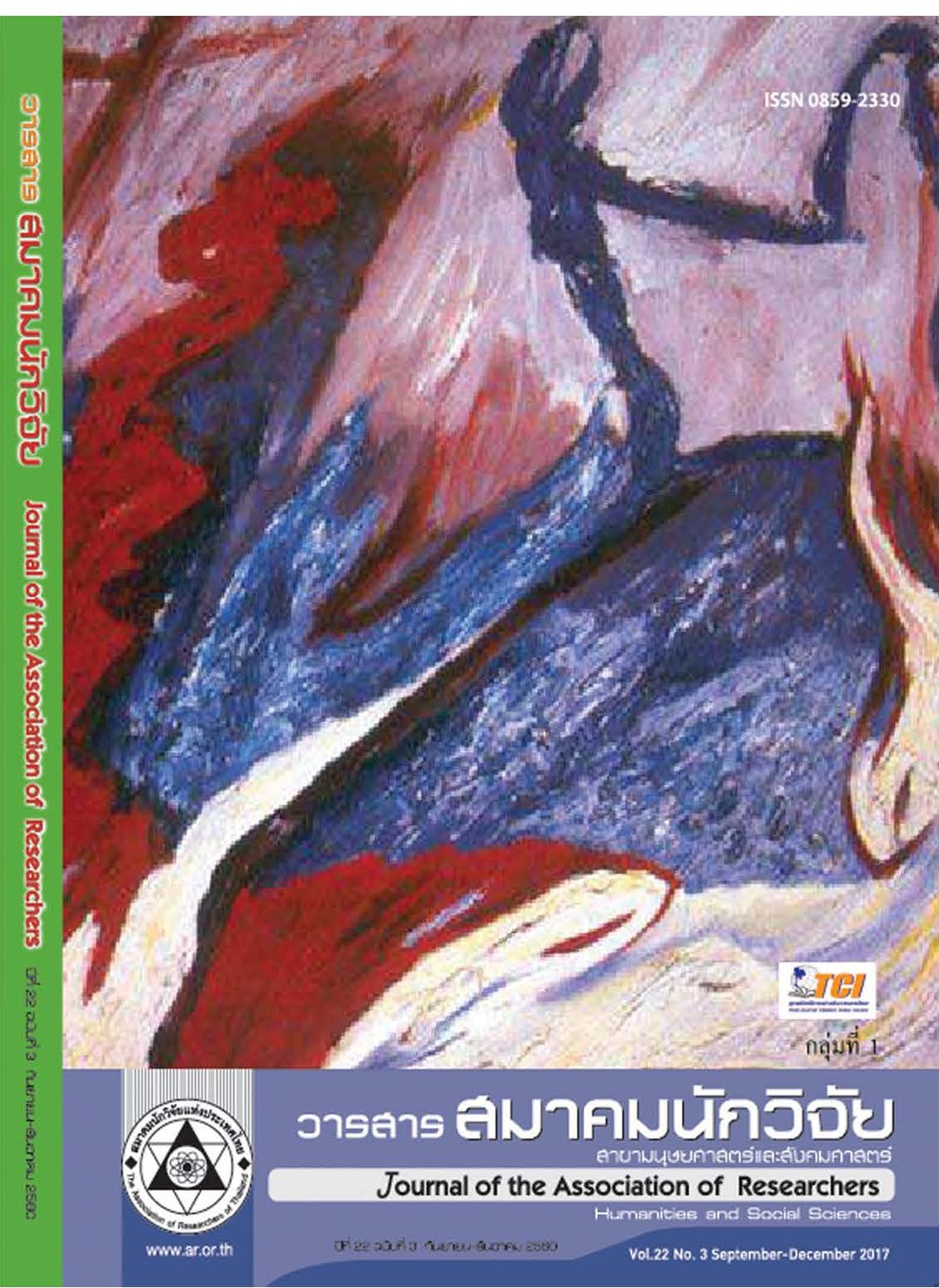Social Impact Assessment Model for Social Services in Higher Education Institutions
Main Article Content
Abstract
The purpose of this research was to develop a social impact assessment model for social services in higher education Institutions. The research involved four steps (1) Analysis and synthesis the factors of social impacts, indicators of social impact and the components of the social impact assessment model. (2) Construction of the social impact assessment model, assessed by 5 experts and 301 instructors from 17 National Universities. (3) Imprementation of the assessment model with 48 instructors from Srinakharinwirot University and 4) Evaluation of the Assessment model by the same group of 48 instructors involving in an imprementation model. The statistics used for analyzing the data were the percentage, mean, standard deviation and second order confirmatory factor analysis. The social impact assessment model for social services in higher education Institutions comprised of five parts: the assessment goal, the assessment object, the assessment operation, the assessor, and the assessment's results judgment. The study also found that the assessment model was propriety at the highest level, feasibility, utility, and accuracy at the high level for all issues, and it can be implemented in the real situations.
Article Details
บทความที่ปรากฏในวารสารนี้ เป็นความรับผิดชอบของผู้เขียน ซึ่งสมาคมนักวิจัยไม่จำเป็นต้องเห็นด้วยเสมอไป การนำเสนอผลงานวิจัยและบทความในวารสารนี้ไปเผยแพร่สามารถกระทำได้ โดยระบุแหล่งอ้างอิงจาก "วารสารสมาคมนักวิจัย"
References
เนาวรัตน์ พลายน้อย. (2552). การประเมินผลโครงการ ม่องการประเมิน: อดีตะปัจจุบัน: อนาคต. สํานักงานคณะกรรมการวิจัยแห่งชาติ (วช.).
พระธรรมปิฎก (ป.อ.ปยุตโต), (2544). การพัฒนาที่ยั่งยืน, (พิมพ์ครั้งที่ 3), กรุงเทพฯ: สํานักพิมพ์ โกมลคีมทอง
พิสณุ ฟองศรี. (2550). การประเมินทางการศึกษา แนวคิดสู่การปฏิบัติ (พิมพ์ครั้งที่ 1). กรุงเทพฯ:
ต่านสุทธาการพิมพ์ (2553). เทคนิควิธีการประเมินโครงการ. กรุงเทพฯ: ต่านสุทธาการพิมพ์ วิชิต
หล่อจระชุณห์กุล และ จิราวัลย์ จิตรเวช. (2555). การพัฒนาดัชนีและตัวชี้วัดการพัฒนาที่ยั่งยืนในระดับภาคสถาบันบัณฑิตพัฒนบริหารศาสตร์
สฤณี อาชวานันทกุล และ ภัทราพร แย้มลออ. (2557). คู่มือการประเมินผลลัพธ์ทางสังคมและผลตอบแทนทางสังคมจากการลงทุน, กรุงเทพฯ: ต่านสุทธาการพิมพ์
สมคิด พรมจัย. (2550). เทคนิคการประเมินโครงการ. (พิมพ์ครั้งที่ 5), นนทบุรี: สํานักพิมพ์จตุพร ดีไซน์
สํานักงานคณะกรรมการพัฒนาการเศรษฐกิจและสังคมแห่งชาติ (2554). สรุปสาระสําคัญแผนพัฒนาเศรษฐกิจและสังคมแห่งชาติ ฉบับที่ 11 พ.ศ. 2555-2559. กรุงเทพฯ: สํานักงานคณะกรรมการพัฒนาการเศรษฐกิจและสังคมแห่งชาติ
สํานักงานคณะกรรมการการอุดมศึกษา. (2556). แผนพัฒนาการศึกษาระดับอุดมศึกษา ฉบับที่ 11 (พ.ศ. 2555 - 2559) กรุงเทพฯ :
โรงพิมพ์แห่งจุฬาลงกรณ์มหาวิทยาลัย (2552) รายงานผลการประชุมหารืออย่างไม่เป็นทางการ นโยบายการศึกษา: การปฏิรูปอุดมศึกษา กรุงเทพฯ :
โรงพิมพ์แห่งจุฬาลงกรณ์มหาวิทยาลัย. (2554), อนุสารอุดมศึกษา ปีที่ 37 ฉบับที่ 394 กรุงเทพฯ: ไอเดียสแคว์
สํานักงานรับรองมาตรฐานและประเมินคุณภาพการศึกษา. (องค์การมหาชน). (2555). คู่มือการประเมินคุณภาพภายนอกรอบสาม (พ.ศ. 2554 - 2558) ระดับอุดมศึกษา ฉบับสถานศึกษา กรุงเทพฯ: บริษัท ออฟเซ็ท พลัส จํากัด
รัตนะ บัวสนธิ์. (2550), ทิศทางและอาณาบริเวณการประเมิน (พิมพ์ครั้งที่ 2). กรุงเทพฯ: จุฬาลงกรณ์มหาวิทยาลัย ศิริชัย กาญจนวาสี. (2550). ทฤษฎีการประเมิน (พิมพ์ครั้งที่ 6), กรุงเทพฯ: จุฬาลงกรณ์มหาวิทยาลัย
References
Achavanuntakul, Sarinee & Yamla-oa, Patraporn. (2014). Social Impact Assessment & Social Return on Investment Handbook Bangkok: Dan Sutthakar. (in Thai).
Alkin, M.C. and F.S. Ellett Jr. (1990). Development of Evaluation Model. in The National Encyclopedia of Educational Evaluation. Oxford: Pergamon.
Burdge, Rabel J. (1994). A Community Guide to Social Impact Assessment. Social Ecology Press.
Dye Thomas R. (1984). Understanding Public Policy.(5th ed). Englewood Cliffs. New Jersey.
Kristensen, P. (2004). The DPSIR framework. UNEP Headquarters, Nairobi, Kenya.
Keeves, John P. (1988). "Model and Model Building" in Educational Research, Methodology and Measurement. An International Handbook, New York: Pergamon.
Licon, C.V. (2004). An Evaluation Model of Sustainable Development Possibilities. Dissertation Abstracts International. 66: 1388-A.
Lorchirachoonkul, Vichit & Jitthavech, Jirawan. (2012). The Development of indicators and indicators for sustainable development at the regional level in Thailand. National Institute of Development Administration. (in Thai).
Nevo, D. (1983). The Conceptualization of Educational Evaluation: An Analytical Review of the Literature, Review of Educational Research. 53: 117-128.
Segnestam, L. (2002). Indicators of Environment and Sustainable Development: Theories and Practical Experiences. World Bank, Environment Department,
Washington D.C. Stufflebeam D.L. and AJ. Shinkfield. (2007). Evaluation Theory, Models and Applications. San Francisco: Jossey-Bass.
Taylor, C. Nicholas, C. Hobson Bryan and Colin C. Goodrich. (1990). Social Assessment Theory, Process and Techniques. Studies in Resource Management No. 7, Lincoln University, New Zealand.
Van de Kerk, Geurt, and Manuel, A.R. (2008). A Comprehensive index for a Sustainable Society: The SSI : the Sustainable Society Index. Journal of Ecological Economics. Wattanachaiyingcharoen, Det. (2007). Social Impact Assessment Phitsanulok Province: Punyavithee group. (in Thai).
World Bank. (1987). Environment, Growth and Development. World Bank, Environment Department, Washington D.C.


